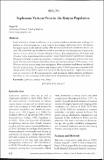| dc.contributor.author | Ongeti, K. | |
| dc.date.accessioned | 2019-07-05T08:24:14Z | |
| dc.date.available | 2019-07-05T08:24:14Z | |
| dc.date.issued | 2011-10 | |
| dc.identifier.issn | 2218-7278 | |
| dc.identifier.uri | http://repository.kemu.ac.ke:8080/xmlui/handle/123456789/517 | |
| dc.description | p. 418 - 421 | en_US |
| dc.description.abstract | Lower extremity venous insufficiency is a common condition and increases with age. In addition to classical symptoms, it may result in skin changes and venous ulcers ... I his disease has a great impact on the patients' quality of life and is associated with considerable health care cost. We assessed the age distribution, mode of presentation and management of saphenous varicose veins in a Christian Mission Hospital in Kenya. Forty adult patients (26 females and 14 males) with a diagnosis saphenous varicose vein at PCEA Kikuyu Hospital were evaluated. The patients' bio data, presenting complains, investigations, management and outcome were noted. The data collected was analyzed for means and variances using the SPSS version 17 for Windows and represented using charts and graphs. Most varicosities were bilateral and affected both the thighs and legs. Six patients were pregnant while 15% of the patients presented with venous ulcers. Most (90%) ulcers were found in the elderly patients. Saphenous varicose veins are common in the Kenyan population. Lack of adequate public education predisposes the elderly in the community to are presentation of saphenous varicose veins with ulcers | en_US |
| dc.language.iso | en | en_US |
| dc.publisher | IJPP | en_US |
| dc.relation.ispartofseries | October - December 2011;Vol. 2, Issue 4 | |
| dc.subject | Saphenous | en_US |
| dc.subject | Varicose Veins | en_US |
| dc.title | Saphenous Varicose Veins in the Kenyan Population | en_US |
| dc.type | Article | en_US |

